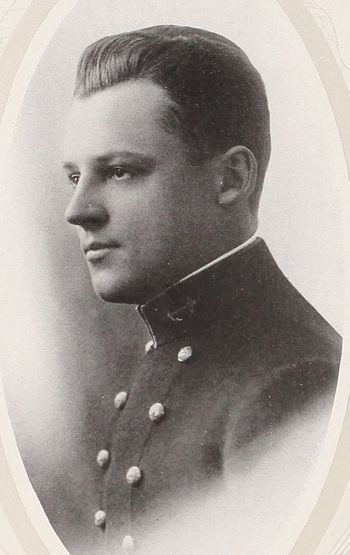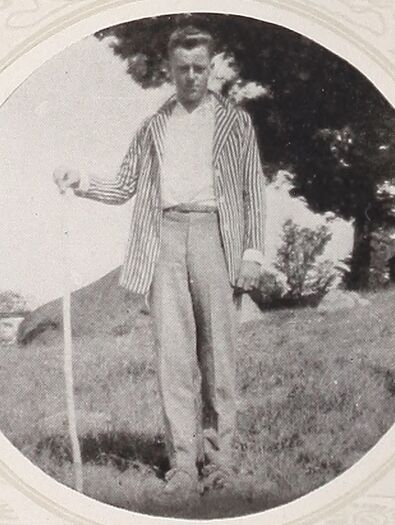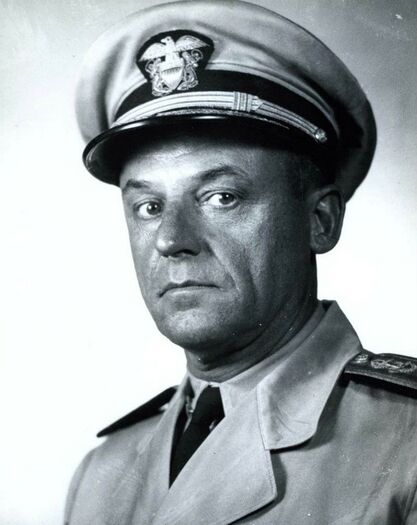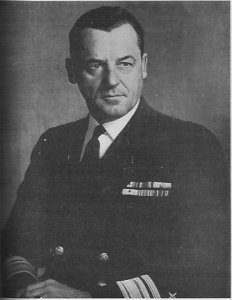THEODORE E. CHANDLER, RADM, USN
Theodore Chandler '15
Lucky Bag
From the 1915 Lucky Bag:
Theodore Edson Chandler
Washington, D.C.
"Ted"
TED spends most of his spare time either in athletic pursuits or in sleeping. He has made good on most of the class teams, and has had the nerve to prefer a hotel bed to a day's liberty in sunny Italy. He has never been a constant fusser, having been somewhat handicapped by those thrust upon him through Faith, Hope and Charity. Not that many a fair maiden hasn't admired his manly beauty, with those dark, curly locks and winning eyes. What a shame that he has spent his Septembers in C—————, New Hampshire, where the lure of the cow-bells has well fortified him against the charms of the society belles. Or is it that a fair damsel in C————— has been claiming our Ted's attention?
Ted has roomed with Spig Field throughout the course, except for those months when Spig was piling up a little sea-duty to help him on his way towards winning that 184-to-5 shot of being an admiral. Although they don't seem to resemble each other in tastes, they have gotten along together famously, and Ted believes nearly everything that Spig says, which is a powerful test of trusting confidence.
Ted has been growing remarkably fast since he entered here in his childhood days, and if he had another year to go, would probably be playing football on the 'Varsity. As it is, his work on the First Class team this year was just about the best that inter-class athletics has ever shown.
Ted is a Navy Junior, but he is a rare form of the species, being quite unmindful of the fact. The very best luck that we can wish him is that he may follow in the footsteps of the "old man," though, we might hope, with a slightly smaller coefficient of form.
Baseball Numerals; Basketball N (1); Basketball Numerals; Football Numerals; Farewell Ball Committee.

Theodore Edson Chandler
Washington, D.C.
"Ted"
TED spends most of his spare time either in athletic pursuits or in sleeping. He has made good on most of the class teams, and has had the nerve to prefer a hotel bed to a day's liberty in sunny Italy. He has never been a constant fusser, having been somewhat handicapped by those thrust upon him through Faith, Hope and Charity. Not that many a fair maiden hasn't admired his manly beauty, with those dark, curly locks and winning eyes. What a shame that he has spent his Septembers in C—————, New Hampshire, where the lure of the cow-bells has well fortified him against the charms of the society belles. Or is it that a fair damsel in C————— has been claiming our Ted's attention?
Ted has roomed with Spig Field throughout the course, except for those months when Spig was piling up a little sea-duty to help him on his way towards winning that 184-to-5 shot of being an admiral. Although they don't seem to resemble each other in tastes, they have gotten along together famously, and Ted believes nearly everything that Spig says, which is a powerful test of trusting confidence.
Ted has been growing remarkably fast since he entered here in his childhood days, and if he had another year to go, would probably be playing football on the 'Varsity. As it is, his work on the First Class team this year was just about the best that inter-class athletics has ever shown.
Ted is a Navy Junior, but he is a rare form of the species, being quite unmindful of the fact. The very best luck that we can wish him is that he may follow in the footsteps of the "old man," though, we might hope, with a slightly smaller coefficient of form.
Baseball Numerals; Basketball N (1); Basketball Numerals; Football Numerals; Farewell Ball Committee.
Loss
Ted died on January 7, 1945 of wounds received the day before when a Japanese kamikaze aircraft struck his flagship, USS Louisville (CA 28) in Lingayen Gulf, Philippine Islands.
Other Information
From Wikipedia:
Theodore Edson Chandler was born at Annapolis, Maryland, in 1894, on the day after Christmas, the son of Rear Admiral Lloyd Horwitz Chandler, USN, and Mrs. (Agatha Edson) Chandler. He was the grandson of William E. Chandler (1835–1917) who served as Secretary of the Navy during the Chester A. Arthur administration and a U.S. Senator from New Hampshire and Lucy Lambert Hale (1841–1915).
He attended Manlius School for Boys, where he was listed under the Order of the Phoenix in the 1911 yearbook, and Swavely's Army and Navy Preparatory School before his appointment to the United States Naval Academy for the Second District of New Hampshire in 1911. As a Midshipman he won letters in basketball and lacrosse. He graduated and was commissioned an Ensign on 4 June 1915. The new officer received orders to report for duty in the battleship Florida. Chandler next served briefly on board the battleship New Hampshire before beginning training in the use of torpedoes at the end of April 1917, on board Montana. On August 2, he completed that assignment and four days later joined the precommissioning complement of the destroyer Conner, then being fitted out at the Philadelphia Navy Yard.
In May 1918, Lieutenant junior grade Chandler sailed in Conner to Brest, France, his destroyer's base during the last six months of World War I. After the Armistice, his service in European waters included a brief term as the temporary commanding officer of Conner.
Chandler returned home in April and, in the following month, reported to the shipyard of the William Cramp & Sons Shipbuilding Co. to help outfit the destroyer Chandler, named in honor of his late grandfather, former Secretary of the Navy William E. Chandler. After her commissioning in September, he served in that ship until December 1920, when he was detached to return to the United States.
On January 2, 1921, he reported for duty at the Naval Postgraduate School at Annapolis, Maryland, and began a 29-month series of ordnance-related studies. On June 1, 1923, he completed training duty and, after a brief leave of absence, reported to Newport News, Virginia, on July 4 for duty in conjunction with the outfitting of the battleship West Virginia. The battleship went into commission on 1 December, and Chandler served in her until 16 January 1925 when he transferred to the battleship Colorado.
In June 1926, newly promoted Lt. Comdr. Chandler came ashore once more for a two-year assignment at the Naval Mine Depot, Yorktown, Virginia. A nine-month tour of duty as gunnery officer in the light cruiser Trenton followed. He reported on board the auxiliary vessel General Alava on April 24, 1929 but was detached only two days later to assume command of the destroyer Pope. In October 1930, he began another series of shore assignments, reporting initially to the Bureau of Ordnance and then to the Army Industrial College before rounding out duty ashore with a brief tour in the office of the Chief of Naval Operations.
On May 30, 1932, Chandler resumed sea duty as gunnery officer on the staff of the Commander Destroyers Battle Force. On February 2, 1934, he assumed command of the destroyer Buchanan. Between August 1935 and June 1938, he served three successive tours as assistant naval attaché: first at Paris, then at Madrid, and finally at Lisbon.
He arrived in Camden, New Jersey, in June 1938 to help fit out the light cruiser Nashville; and he served as her executive officer until July 1940. Next, he returned to Washington, D.C. for a 15-month assignment in the office of the Chief of Naval Operations. Near the end of that tour of duty, he was promoted to captain on July 18, 1941.
Chandler relieved Capt. P. P. Powell as commanding officer of the light cruiser Omaha on October 15. Shortly over three weeks later, an event occurred that highlighted Chandler's tour in command of the light cruiser. On the morning of November 6, 1941, Omaha, in company with the destroyer Somers, came across a darkened ship that acted suspiciously when challenged. That ship—although bearing the name Willmoto and purportedly operating out of Philadelphia—proved to be the German blockade runner Odenwald, bound for Germany with 3,857 metric tons of raw rubber in her holds. Scuttled by her crew, the German ship began to sink; but Capt. Chandler sent a party on the German vessel that controlled the flooding and salvaged the ship. It proved to be the last time that American sailors received prize money.
For most of the next 18 months, Omaha cruised the waters of the South Atlantic in search of German blockade runners and submarines. That tour of duty ended in April 1943, when Chandler was selected to command United States naval forces in the Aruba-Curaçao area. On May 3, 1944, he was promoted to rear admiral. In July 1944, Rear Admiral Chandler took command of Cruiser Division 2 (CruDiv 2), Atlantic Fleet. In that capacity, he participated in Operation Dragoon, the invasion of southern France in mid-August, and commanded the "Sitka-Romeo" force which captured the Iles d'Hyeres just off the coast of Provence.
Shortly thereafter, Rear Admiral Chandler was given command of Battleship Division 2 (BatDiv 2) of the Pacific Fleet.
He reported for duty on October 2 in time to command his ships — part of Rear Admiral Jesse B. Oldendorf's bombardment group — during the Leyte invasion and helped to repulse the Japanese southern attack group—Vice Admirals Shoji Nishimura's Force “C” and Kiyohide Shima's 2d Striking Force—in the Surigao Strait phase of the Battle for Leyte Gulf.
On December 8, 1944, Rear Admiral Chandler was shifted to command of CruDiv 4 and flew his flag above USS Louisville. During the voyage from Leyte to Lingayen for the invasion of Luzon, Chandler's cruisers came under heavy Japanese air attacks—mostly by kamikazes.
Late in the afternoon of January 5, 1945, a group of sixteen kamikazes swooped in on the force then about 100 miles (200 km) from Manila Bay. One of the four successful kamikazes crashed into Rear Admiral Chandler's flagship USS Louisville at her number No. 2 main battery 8-inch 55 caliber gun knocking it completely out of commission, but continued her bombarding mission and downed several planes. On January 6, 1945 the cruiser suffered more severely during a repeat performance. At 17:30, another kamikaze plunged into the cruiser's starboard side at the signal bridge where explosives wrought havoc. Rear Admiral Chandler jumped from the bridge to the signal bridge though horribly burned by gasoline flames, Chandler helped deploy fire hoses alongside enlisted men to stop the flames and then waited his turn for first aid with those same ratings. The admiral, his lungs scorched very severely, was beyond help. He died the next day January 7, 1945 in spite of the efforts of the medical department. Admiral Chandler is listed on the Tablets of the Missing at the Manila Philippines National Cemetery.
From Naval History and Heritage Command:
In addition to the Navy Cross, Silver Star Medal, Legion of Merit with Gold Star and the Commendation Ribbon, Rear Admiral Chandler had the Victory Medal, Destroyer Clasp; the Yangtze Service Medal; American Defense Service Medal with bronze "A;" American campaign Medal; European-African-Middle Eastern Campaign Medal; and was entitled to the Asiatic-Pacific Campaign Medal; and the World War II Victory Medal. He had also been awarded the Orden Nacional de Cruzeriro de Sul (grade of official) and diploma by the Government of Brazil, and the Legion of Honor (Officer) and diploma by the Government of France; and the Order of Orange-Nassau with Swords (rank of Grand Officer) had been conferred upon him by Queen Wilholnina of The Netherlands.
In addition to being memorialized on the Tablets of the Missing at the Manila Philippines National Cemetery, he has memorial markers in Washington, D.C. and in Arlington National Cemetery.
His wife, Beatrice, was listed as next of kin. He has a memorial marker in Arlington National Cemetery.
Photographs
From Hall of Valor:
The President of the United States of America takes pride in presenting the Navy Cross (Posthumously) to Rear Admiral Theodore Edson Chandler (NSN: 0-9050), United States Navy, for extraordinary heroism and distinguished service in the line of his profession as Commander, Cruiser Division FOUR, aboard the Heavy Cruiser U.S.S. LOUISVILLE (CA-28), in action against enemy Japanese forces in the Lingayen Gulf, Philippine Islands, on 6 January 1945. Skillfully coordinating the fire of his division with that of other heavy naval units during the initial bombardment of Luzon prior to scheduled landing operations at Lingayen, Rear Admiral Chandler ordered the smashing broadsides of his powerful guns with unrelenting aggressiveness despite a heavy overcast which reduced visibility and while under persistent attack by enemy aircraft. Observing the progress of operations from an exposed position on the flag bridge when a Japanese suicide bomber attacked and hit his cruiser, setting the flag bridge afire, he emerged from the raging inferno with his clothing ablaze. Determined to remain in action, he steadfastly continued to direct his units until compelled by his Chief of Staff to proceed to the dressing station for treatment of severe burns. Stout-hearted and indomitable in the face of almost certain death, Rear Admiral Chandler succumbed to his injuries the following day. By his inspiring devotion to duty and heroic spirit of self-sacrifice throughout, he enhanced and sustained the highest traditions of the United States Naval Service. He gallantly gave his life for his country.
General Orders: Bureau of Naval Personnel Information Bulletin No. 344 (November 1945)
Service: Navy
Division: Cruiser Division 4 (Aboard the U.S.S. Louisville (CA-28)
Rank: Rear Admiral
Army Distinguished Service Medal
From Hall of Valor:
The President of the United States of America, authorized by Act of Congress, July 9, 1918, takes pride in presenting the Army Distinguished Service Medal (Posthumously) to Rear Admiral Theodore Edson Chandler (NSN: 0-9050), United States Navy, for conspicuous service to the Army of the United States in the action supporting the return of United States Forces to the Island of Luzon. Through his outstanding gallantry and exceptional skill while in command of battleship division in support of landing operations during the Battle of Leyte Gulf and while later commanding a cruiser squadron in the battle of Lingayen Gulf, Admiral Chandler was an inspiration and example to the forces of both the Army and the Navy. By his effective cooperation he assisted materially in the solution of complex problems of joint operations and his death on 7 January 1945 from wounds received while leading his command in action constituted a severe loss. The services performed by Admiral Chandler represent a very material contribution to the fulfillment of the Philippine Campaign.
General Orders: War Department, General Orders No. 7 (1945)
Service: Navy
Division: Cruiser Division 4 (Aboard the U.S.S. Louisville (CA-28)
Rank: Rear Admiral
Silver Star
From Hall of Valor:
The President of the United States of America takes pride in presenting the Silver Star (Posthumously) to Rear Admiral Theodore Edson Chandler (NSN: 0-9050), United States Navy, for conspicuous gallantry and intrepidity as Commander, Battleship Division TWO, in action against major units of the enemy Japanese Fleet during the Battle of Surigao Strait in the early hours of 25 October 1944. When a formidable column of Japanese warships entered the narrow confines of the Strait and advanced under cover of darkness toward our waiting forces, Rear Admiral Chandler, with his division placed among other battleships in the strategic T-formation across the northern end of Surigao, hurled the full power of his heavy guns at the confused enemy force. Directing the shattering broadsides of his mighty vessels with unrelenting fury, he waged fierce battle against the enemy in a prolonged engagement which resulted in the destruction of two Japanese battleships and three destroyers before effective return fire could be brought to bear on our ships. Subsequently retiring his division unscathed from the action, Rear Admiral Chandler, by his brilliant leadership, outstanding professional skill and indomitable fighting spirit in the face of tremendous odds, contributed materially to the defeat of the enemy in this decisive action and his undaunted courage throughout upheld the highest traditions of the United States Naval Service.
Service: Navy
Division: Battleship Division 2
Rank: Rear Admiral
Legion of Merit
From Hall of Valor:
The President of the United States of America takes pleasure in presenting the Legion of Merit to Rear Admiral Theodore Edson Chandler (NSN: 0-9050), United States Navy, for exceptionally meritorious conduct in the performance of outstanding services to the Government of the United States as Commander All Forces, Aruba-Curacao, from 27 April 1943 to 25 July 1944. Admiral Chandler exercised sound judgment and initiative in carrying out his many and varied tasks. He was largely responsible for the cooperative employment of U.S. and Netherlands naval and air forces in waging vigorous and effective warfare on enemy submarines. He displayed marked diplomatic ability in his contacts with Netherlands and Venezuelan civil and military officials.
General Orders: Bureau of Naval Personnel Information Bulletin No. 334 (January 1945)
Service: Navy
Rank: Rear Admiral
From Hall of Valor:
(Citation Needed) - SYNOPSIS: Rear Admiral Theodore Edson Chandler (NSN: 0-9050), United States Navy, was awarded a Gold Star in lieu of a Second Award of the Legion of Merit for exceptionally meritorious conduct in the performance of outstanding services to the Government of the United States during World War II.
General Orders: American Battle Monuments Commission
Service: Navy
Rank: Rear Admiral
From the Bureau of Naval Personnel Information Bulletin No. 300 (March 1, 1942), the Secretary of the Navy addressed a commendation letter to Theodore:
Your operations on the occasion of the seizure of the German Motor Ship ODENWALD on November 6, 1941 are noted with great interest.
The identification of the ODENWALD by you as a hostile ship, even though disguised as to nationality by the flying of and otherwise subversive use of the United States Flag, the subsequent salvage of and the taking into port of the ODENWALD under her own power by the salvage and boarding parties sent by your direction from the Task Group under your command bespeaks of the efficient plans made for such an emergency, and made possible the saving of the ship under the attendant hazardous conditions.
You are hereby commended for your initiative and sound judgment on this occasion.
Namesakes
USS Theodore E. Chandler (DD 717) was named for Ted; the ship was sponsored by his widow.
USS Chandler (DDG 996) was also named for Ted.
Related Articles
His daughter married John Green '42, who was killed in action in the Mediterranean in September 1943.
The "Register of Commissioned and Warrant Officers of the United States Navy and Marine Corps" was published annually from 1815 through at least the 1970s; it provided rank, command or station, and occasionally billet until the beginning of World War II when command/station was no longer included. Scanned copies were reviewed and data entered from the mid-1840s through 1922, when more-frequent Navy Directories were available.
The Navy Directory was a publication that provided information on the command, billet, and rank of every active and retired naval officer. Single editions have been found online from January 1915 and March 1918, and then from three to six editions per year from 1923 through 1940; the final edition is from April 1941.
The entries in both series of documents are sometimes cryptic and confusing. They are often inconsistent, even within an edition, with the name of commands; this is especially true for aviation squadrons in the 1920s and early 1930s.
Alumni listed at the same command may or may not have had significant interactions; they could have shared a stateroom or workspace, stood many hours of watch together, or, especially at the larger commands, they might not have known each other at all. The information provides the opportunity to draw connections that are otherwise invisible, though, and gives a fuller view of the professional experiences of these alumni in Memorial Hall.
January 1916
January 1917
January 1919
January 1920
January 1921
January 1922
May 1923
July 1924
September 1924
November 1924
January 1925
May 1925
July 1925
October 1925
January 1926
October 1926
January 1927
April 1927
October 1927
January 1928
April 1928
July 1928
October 1928
January 1929
April 1929
July 1929
October 1929
January 1930
April 1930
October 1930
January 1931
April 1931
July 1931
October 1931
January 1932
April 1932
October 1932
January 1933
April 1933
July 1933
October 1933
April 1934
July 1934
October 1934
January 1935
April 1935
October 1935
January 1936
April 1936
July 1936
January 1937
April 1937
September 1937
January 1938
July 1938
January 1939
June 1940
November 1940
April 1941
Theodore is one of 15 members of the Class of 1915 on Virtual Memorial Hall.

The "category" links below lead to lists of related Honorees; use them to explore further the service and sacrifice of alumni in Memorial Hall.


